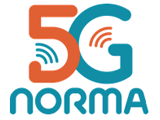- 5G NORMA project, part of the 5G Infrastructure Public-Private Partnership (5GPPP) initiative, will define the overall 5G mobile network architecture, including radio and core networks, to meet the demanding 5G multiservice requirements
- Consortium composed of 13 partners among leading industry vendors, operators, IT companies, small and medium-sized enterprises and academic institutions
 Industry vendors, operators, IT companies, small and medium-sized enterprises and academia in Europe have joined forces to develop a novel, adaptive and future-proof mobile network architecture for the 5G era. As part of the 5GPPP initiative, 5G NORMA (5G Novel Radio Multiservice adaptive network Architecture) will propose an end-to-end architecture that takes into consideration both Radio Access Network (RAN) and Core Network aspects. The consortium will be working over a period of 30 months, beginning in July 2015, to meet the key objectives of creating and disseminating innovative concepts on the mobile network architecture for the 5G era.
Industry vendors, operators, IT companies, small and medium-sized enterprises and academia in Europe have joined forces to develop a novel, adaptive and future-proof mobile network architecture for the 5G era. As part of the 5GPPP initiative, 5G NORMA (5G Novel Radio Multiservice adaptive network Architecture) will propose an end-to-end architecture that takes into consideration both Radio Access Network (RAN) and Core Network aspects. The consortium will be working over a period of 30 months, beginning in July 2015, to meet the key objectives of creating and disseminating innovative concepts on the mobile network architecture for the 5G era.
5G networks need to meet a wide array of diverse and extreme requirements
There will be a need for super fast and reliable connectivity with virtually zero latency for use cases such as remote control of robots, and support for billions of sensors and things. 5G will also need to provide consistent and high quality connectivity for people and things. In addition, 5G networks will combine revolutionary technologies and existing mobile radio generations, as well as Wi-Fi, into a new system. A new mobile network architecture is required to manage these complex multi-layer and multi-technology networks, and to build in flexibility even for applications that are yet to be envisioned.
5G NORMA: a novel, multiservice mobile network architecture
 With the 5G NORMA project, leading players in the mobile ecosystem aim to underpin Europe’s leadership position in 5G. The NORMA approach breaks away from the rigid legacy network paradigm. It will on-demand adapt the use of the mobile network (RAN and Core Network) resources to the service requirements, the variations of the traffic demands over time and location, and the network topology, which include the available front/backhaul capacity.
With the 5G NORMA project, leading players in the mobile ecosystem aim to underpin Europe’s leadership position in 5G. The NORMA approach breaks away from the rigid legacy network paradigm. It will on-demand adapt the use of the mobile network (RAN and Core Network) resources to the service requirements, the variations of the traffic demands over time and location, and the network topology, which include the available front/backhaul capacity.
The consortium envisions the architecture will enable unprecedented levels of network customizability to ensure that stringent performance, security, cost and energy requirements are met. It will also provide an API-driven architectural openness, fueling economic growth through over-the-top innovation.
The technical approach is based on the innovative concept of adaptive (de)composition and allocation of network functions, which flexibly decomposes the network functions and places the resulting functions in the most appropriate location. By doing so, access and core functions may no longer reside in different locations, which is exploited to jointly optimize their operation whenever possible. The adaptability of the architecture is further strengthened by the innovative software-defined mobile network control and mobile multi-tenancy concepts and underpinned by corroborating demonstrations.
A socio-economic analysis of the benefits of 5G NORMA innovations will also be conducted. This will determine the value to the wireless industry, the users in society and the public sphere of enhanced services enabled by the proposed architecture.
Dr. Werner Mohr, Chairman of the 5GPPP Association and Head of Research Alliances for  Nokia Networks, said: “5G is not only about new radio access technology, network architecture will play an important role as well. 5G networks will have to be programmable, software driven and managed holistically to enable a diverse range of services in a profitable way. With 5G NORMA, the consortium aims to ensure economic sustainability of the network operation and open opportunities for new players, while leveraging a future-proof architecture in a cost- and energy-effective way.”
Nokia Networks, said: “5G is not only about new radio access technology, network architecture will play an important role as well. 5G networks will have to be programmable, software driven and managed holistically to enable a diverse range of services in a profitable way. With 5G NORMA, the consortium aims to ensure economic sustainability of the network operation and open opportunities for new players, while leveraging a future-proof architecture in a cost- and energy-effective way.”
5G NORMA deliverables
The consortium will be working over a period of 30 months, beginning in July 2015. Key objectives include the creation and dissemination of innovative concepts on the 5G mobile network architecture for the 5G era. Some of these may be captured in products or patents, while others may emerge from the process and working engagements. Emphasis will also be placed on commercialization, including partnerships and start-up creation.
Industry players included in the consortium
- Vendors and IT: Alcatel-Lucent, NEC, Nokia Networks, ATOS
- Operators: Deutsche Telekom, Orange, Telefonica
- Small and Medium-sized Enterprises: Azcom Technology, Nomor Research, Real Wireless
- Academia: University Kaiserslautern in Germany, Kings College London, University Carlos III Madrid
Dr. Albert Banchs, an Associate Professor at the Department of Telematics Engineering of University Carlos III of Madrid (UC3M) and the Deputy Director of IMDEA Networks Institute, also in Madrid (Spain), is the Principal Investigator at UC3M for this project.
- 5G NORMA website
- AlphaGalileo news service:
- TENDENCIAS21- Tendencias de las telecomunicaciones: Dos años y medio para montar la arquitectura de las redes 5G

